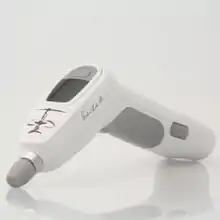The Activator Method Chiropractic Technique is a chiropractic treatment method and device created by Arlan Fuhr as an alternative to manual manipulation of the spine or extremity joints. The device is categorized as a mechanical force manual assisted (MFMA) instrument which is generally regarded as a softer chiropractic treatment technique.[1]

Activator Adjusting Instrument

The traditional Activator Adjusting Instrument (AAI), or more simply, Activator, is a small handheld spring-loaded instrument which delivers a controlled and reproducible impulse to the spine.[2] With the release of the Activator V this process has changed from a spring-loaded grip to an electronic tool which delivers the mechanical force. It was found to give off no more than 0.3 J of kinetic energy in a 3-millisecond pulse.[2] The aim is to produce enough force to move the vertebrae, but not enough to cause injury.[3] The design of the tool was based on a dental impactor.[2]
Activator I was the first product patented by Activator Methods International on September 26, 1978.[2][4][5]
In 1994 the Activator II was first released when research at the University of Vermont found that when the initial instrument was given an impedance head it produced a "significant improvement in the frequency content" of the force delivered to the spine. This led to a better activation of mechanoreceptors when adjusting a specific segment of the spine.[2]
Activator V is the newest iteration of Activator products and is a cordless instrument capable of delivering its own adjustment. It is the first FDA registered and approved cordless electronic chiropractic adjustment instrument.[6]
Leg length test reliability
Although prone "functional leg length" is a widely used chiropractic tool, it is not a recognized anthropometric technique, since legs are often naturally of unequal length, and measurements in the prone position are not entirely valid estimates of standing X-ray differences.[7] Measurements in the standing position are far more reliable.[8] Another confounding factor is that simply moving the two legs held together and leaning them imperceptibly to one side or the other produces different results.[9][10] The Activator Methods technique uses leg length checks while prone (Position 1) and with the knees bent to 90 degrees (Position 2). Research shows good intraexaminer reliability and moderate interexaminer reliability with leg length checks in position 1, however no consensus has been met on the accuracy of leg length checks in position 1.[3]
Utilization rates
In 2003, the National Board of Chiropractic Examiners found that 69.9% of chiropractors used the technique, and 23.9% of patients received it.[11] The majority of US chiropractic schools and some schools in other countries teach the AMCT method, and an estimated 45,000 chiropractors worldwide use AMCT or some part of the technique.[3]
Results
There have been a number of studies of AMCT, including case reports, clinical studies and randomized controlled trials. A few studies suggest that the activator may be as effective as manual adjustment in treatment of back pain.[3]
See also
References
- ↑ Chiropractic: An Illustrated History. Mosby. 1995. ISBN 978-0-8016-7735-9.
- 1 2 3 4 5 Fuhr, Arlan W.; Colloca, Christopher J.; Green, John R.; Keller, Tony S. (1997). Activator Methods Chiropractic Technique (1st ed.). St. Louis, MO: Mosby. ISBN 0-8151-3684-6.
- 1 2 3 4 Fuhr, Arlan W.; J. Michael Menke (February 2005). "Status of Activator Methods Chiropractic Technique, Theory, and Practice". Journal of Manipulative and Physiological Therapeutics. 28 (2): e1–e20. doi:10.1016/j.jmpt.2005.01.001. PMID 15800504.
- ↑ "United States Patent - Chiropractic Adjusting Instrument". United States Patent and Trademark Office. Retrieved 3 September 2017.
- ↑ "Patent Images". United States Patent and Trademark Office. Retrieved 3 September 2017.
- ↑ "510(k) Summary of Safety and Effectiveness" (PDF). DEPARTMENT OF HEALTH & HUMAN SERVICES. Retrieved 3 September 2017.
- ↑ D W Rhodes, E R Mansfield, P A Bishop, J F Smith. The validity of the prone leg check as an estimate of standing leg length inequality measured by X-ray. Archived 2011-05-22 at the Wayback Machine J Manipulative Physiol Ther.; 18 (6):343-6
- ↑ E Hanada, R L Kirby, M Mitchell, J M Swuste. Measuring leg-length discrepancy by the "iliac crest palpation and book correction" method: reliability and validity. Archived 2011-05-22 at the Wayback Machine Arch Phys Med Rehabil. 2001 Jul; 82 (7):938-42
- ↑ Mitchell, Jacqueline S. (June 4, 2002). "Keeping Your Spine In Line". PBS. Archived from the original on June 28, 2002.
- ↑ "Adjusting the Joints". PBS. Archived from the original on June 28, 2002.
- ↑ Christensen MG, Kollasch MW (2005). "Professional functions and treatment procedures" (PDF). Job Analysis of Chiropractic. Greeley, CO: National Board of Chiropractic Examiners. pp. 121–38. ISBN 1-884457-05-3. Archived from the original (PDF) on 2008-09-10. Retrieved 2008-08-25.